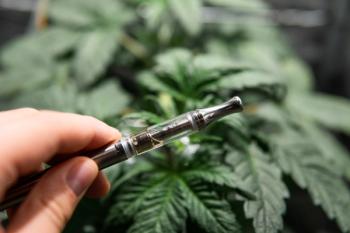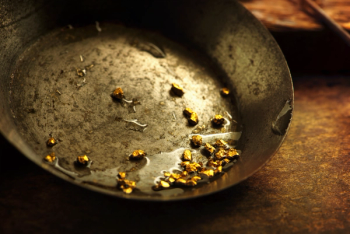
Acidic and Neutral Cannabinoids Explained: An Interview with Jaqueline McGrane of Boulder Creek Technologies, Part II

In Part II of this interview, Jaqueline McGrane, Senior Vice President of Business Development at Boulder Creek Technologies (BCT) explains the importance of consumers being able to recognize the differences between acidic and neutral cannabinoids, especially when considering current product labelling practices.
Can you tell us about the roles that acidic and neutral cannabinoids play in cannabis products?
Jaqueline McGrane: I think it's very important to divide cannabis products up into neutral cannabinoid products and acidic cannabinoid products. In terms of products on the market today, you see this big divergence. Anything that's edible, for example, is a neutral cannabinoid because you're not heating it up, you're just eating it, so it has been pre-decarboxylated by distillate products. All distillate products are neutral. They've already been decarboxylated and are psychoactive. That way, when you vaporize them in the vape pen, they're ready to go.
The acidic products, on the other hand, are the flower itself. As we know, a lot of the reason that you need to smoke cannabis or vaporize a dab is because you're turning that tetrahydrocannabinolic acid (THCA) into tetrahydrocannabinol (THC). THCA, of course, needs to be decarboxylated to become a neutral cannabinoid, THC. And THC is the psychoactive component of the product. Throughout all of history, that's been the main reason that you have to heat up your cannabis and burn it. You need to put them in a joint or a bowl to heat them up and convert it. Dabbable products like butane hash oil (BHO) or rosin, are acidic products. BHO is a cold extraction with a hydrocarbon solvent. You're not going to be decarboxylating or turning that THCA into THC. That’s why you need to vaporize dabbable products. That's why you put them on your hot ceramic nail and decarboxylate them.
That’s very simplistic, but that gives you a start on being able to look at what products are on the market. Acidic cannabinoid products need to be heated or lit on fire in some way to decarboxylate, while neutral cannabinoid products are ready to go in edibles and distillate.
Why is it important for consumers to know the difference between acidic cannabinoids and neutral cannabinoids? And what are some misconceptions that you see among consumers?
McGrane: The main thing from a recreational point of view is to know what your product contains so you can know how to use it effectively to get that recreational effect. From a medical point of view, it's important to understand that there are big differences in how the acidic and the neutral versions—even of the same cannabinoid—affect your physiology. And if you can understand that, you can create a much more efficacious use of cannabinoid products for your particular symptomatology or your particular issue that you're trying to solve.
I would say that for just a regular consumer of cannabis, it's important to understand what you're getting, what you're buying, and how to use it. I remember about 10 years ago, for example, people would try to make vape pens and would just mix straight BHO with propylene glycol. Not very many people do that anymore, but they used to and then sell it. Propylene glycol has such a low vaporization point that customers would be smoking and vaporizing and it wouldn't be converting from the THCA to the THC very much. You get such a low conversion rate that basically they wouldn't be getting high. They'd be spending all this money on this product and they would be trying to get some kind of effect out of it, but they wouldn't be getting the effect they wanted. It's actually interesting because back in the day, I came out with the vape pen line under the Sweet Mary Jane brand. I decarboxylated my BHO before I made the vape pen and everybody would come and say, “Oh my god, this vape pen has such a huge effect.” And I'd explain, “yeah, it’s decarboxylated. All these other pens are not decarboxylated. It's just straight BHO mixed with propylene glycol put in a pen with a wick.”
It's also important from the medical point of view to be able to understand the use of acidic versions of cannabinoids, particularly if you don't want to have the psychoactive effects. The cool part about cannabis is that it has both recreational and medicinal purposes. Acidic cannabinoids do have a very large place in medicinal applications. Acidic cannabinoids generally are much better at being anti-inflammatory agents. THCA, for example, is a much better anti-inflammatory agent than THC. Consequently, if you're trying to use cannabis from a medicinal point of view and you're trying to say, treat rheumatism or some kind of inflammatory chronic disease like arthritis, you can use acidic cannabinoids quite effectively, especially if you're not trying to get stoned. For a consumer, such as an older adult, who wants to treat inflammation but doesn’t want to get high, they can use acidic cannabinoids to do that and actually get the effect they're looking for because then they're not going to have that psychoactivity. They get the medicinal aspect without any of the recreational aspect, which is wonderful.
That's really the beauty of cannabinoids, in my mind. You can have so many different applications. We recently saw this explosion of people wanting to use cannabidiolic acid (CBDA) because there were a couple papers out that said CBDA was very effective at treating the symptomatology of COVID versus cannabidiol (CBD). All of a sudden there was this big demand for CBDA because the acidic version of that cannabinoid actually had a larger effect in fighting COVID than CBD did.
How can consumers tell what's in their products, especially considering labeling issues across the country? For example, let's say a novice cannabis user went to a shop or a medicinal facility, and the labels didn't say if the product was acidic or neutral. What kind of resources would the consumer be able to use to find out this information?
McGrane: In most states, you're going to be able to see the testing of the products on the label. A lot of people don't pay attention to this, but they really should. For example, every gram of concentrate will list on the box your basic cannabinoids—your THCA, THC, CBDA, CBD, and some of the minors—depending on the state. From a consumer point of view, you always want to start by looking at that label. There's also the whole other question of quality. You used to be able to go to the bud tender and say, “open up this jar concentrate. Let me look at it. Let me smell it.” The smell and the color and the consistency of the product is just so important from a quality point of view.
For example, I was in Nevada the other day and I was buying a product. And of course, nowadays you can't see what you're buying. You just have to look at the label. And I looked at the label and I was like, okay, this looks like it's good. It has this much THCA, it has like the terpenes that I’m looking for, specific terpenes that I'm looking for and I'm going to buy it.
So, I bought it and opened it up, and it was just horrible. It was filled with butane, smelled just like butane. It was brown. It wasn't even the consistency that you look for in like a shatter or wax or a live resin. It was just this like oil, essentially, and it was horrible. I mean, I smoked like two dabs and I was like, I'm done. I’ll just throw this away. It’s just a waste of $60 because of course, in Nevada, everything is so expensive.
It's harder and harder nowadays for consumers to be able to get a deep understanding of what they're purchasing. There's also methodologies and use that they can't really see from the label. For example, the label doesn't have anything about presence of butane or presence of propane from hydrocarbon products. It just says that it passed a residual solvent analysis (RSA). In a lot of states, the actual parts per million (ppm) that are acceptable for passing are quite high. In some states, it's 2000 ppm. Butane is totally acceptable, so when you have it, you don't know it.
A lot of customers, at least in more mature markets like Colorado, for example, where customers have been buying product for a long time, they're getting more and more savvy. They start to look for products that they know will be consistent even if they can't see it. They'll find solvent-less products like rosins. With rosin product, there's never going to be any solvent, there’s never going to be butane, propane, or ethanol.
You can trust that you're not going to have any of those solvents because of how the product is made. It’s the same with Vapor-Static. That's a big reason that why BCT is focused on this is. A customer in a market where they can’t dive in and open up a product and smell it and see it before they buy it can at least know when they see that it's Vapor-Static extracted, they're not going to be getting any solvents in what they're consuming.
My number one suggestion for consumers is to buy several products, check the labeling, make sure you have the cannabinoids that you're looking for in the ratios that you're looking for, and check that the terpenes are good. Buy a couple products from different brands. Get your brands that are consistent and produce high quality products. I find that if you just focus 100% on the cheapest product or get bamboozled by packaging, oftentimes you're going to be disappointed and sometimes you're just unlucky. I've been in the industry for 10 years, and I did everything right. I checked the label. I look at it. Sometimes they have a little display. They didn't have a little display in Nevada and I bought it, and it ended up being a bad product. You're not going to be able to use techniques all the time that'll get you to 100% high quality stuff that you're looking for. But there are ways that you can mitigate that. Go to dispensaries that actually have displays of their product. I was going to this dispensary in Nevada, you couldn't even see what you were buying. It was just like a list that had like the THC and CBD number and some of the terpene data. And that was all I had. And if I hadn't been just driving through on my way to California, I would have probably taken the time and I would have been like, this isn't the dispensary for me. You want to go find a dispensary, (A) that has displays and good data, and (B) that has budtenders that'll actually take the time to really explain things.
Budtenders have such an important function. Some dispensaries are so corporatized nowadays; you don't get to talk to anybody and no one really knows anything about what they're selling. There are good dispensaries that have budtenders who will take the time to learn what you're looking for and be able to have reliable suggestions of products.
As a consumer, I say, you want to do your research. You want to go to a couple of dispensaries and find the one that's right for you, one that has good bud tenders and good displays. Then focus on finding a set of products that work for you and sticking with those brands, but obviously try some new stuff every once in a while. The best way to ensure that you have consistent quality product is to find what you want and stick with it. It might take a little while. One of the things I always feel so sad about is when somebody buys a product and it's too gnarly, so they give up on the whole concept because they had this one bad experience.
If you get a product and it's not great, go somewhere else, find another one. There will always be good companies and good products in every single state. In Colorado, there's quite a few because we have such a long experience with making high quality cannabis. In other states, there might be less, but you can always find them.
It’s important from a consumer perspective to know what you're trying to get out of it. Let's say you're trying this whole concept of THC, CBD ratios, and terpenes. If you're trying to get very high, to have an extremely energetic effect, you're looking for THC. You're not trying to attenuate that with any CBD. So that's how you can think, “okay, I want to get super high. I want a sativa effect. I want energy. All this stuff.” If you want a more relaxing effect, for example, you're going to look for terpenes like myrcene. Myrcene is a great way to know that something is going to be relaxing. Almost all heavy indicas, OG indicas have a high amount of myrcene and then, of course, higher amounts of CBD. CBD attenuates the effect of THC, creates a more relaxing experience.
Is there anything else you'd like to add?
I definitely am very passionate about this. If you'd like to learn more about Boulder Creek Technologies, check out our website
For part I of this interview, please click this link:
Newsletter
Unlock the latest breakthroughs in cannabis science—subscribe now to get expert insights, research, and industry updates delivered to your inbox.



